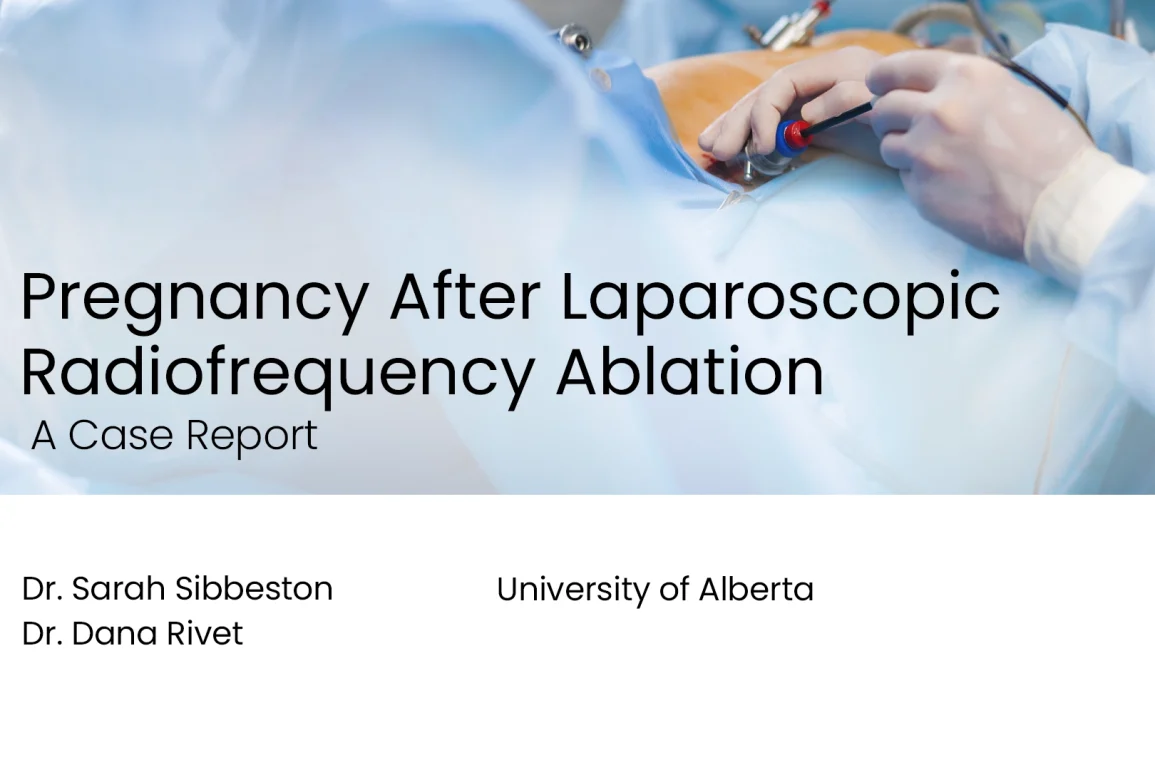Table of Contents
- Procedure Summary
- Authors
- Youtube Video
- What is Pregnancy After Laparoscopic Radiofrequency Ablation?
- What are the Risks of Pregnancy After Laparoscopic Radiofrequency Ablation?
- Video Transcript
Video Description
A unique case report detailing a successful pregnancy following laparoscopic radiofrequency ablation for fibroids, with insights on fertility and surgical outcomes.
Presented By
Affiliations
University of Alberta
Watch on YouTube
Click here to watch this video on YouTube.
What is Pregnancy After Laparoscopic Radiofrequency Ablation?
Pregnancy after laparoscopic radiofrequency ablation refers to conception and gestation in a uterus previously treated with Lap-RFA for fibroids. Here’s what is important to know:
-
Procedure Overview: Lap-RFA uses laparoscopic ultrasound to identify fibroids, followed by insertion of a radiofrequency probe to deliver controlled thermal energy that causes coagulative necrosis and shrinkage of fibroid tissue.
-
Current Indication: The technique is approved for symptom relief in women with fibroids (e.g., abnormal bleeding, pelvic pain, bulk symptoms) but not as a fertility treatment.
-
Pregnancy Considerations: Although not formally recommended for patients seeking pregnancy, published case reports and small series describe successful conceptions after Lap-RFA with outcomes comparable to myomectomy in limited data.
-
Mechanism of Benefit: By reducing fibroid volume and improving uterine contour, Lap-RFA may indirectly enhance fertility potential in select patients, though robust evidence is lacking.
-
Counseling Point: Patients desiring pregnancy should be informed that long-term data on fertility, placentation, and uterine rupture risk remain limited, and that close obstetric monitoring is required.
What are the Risks of Pregnancy After Laparoscopic Radiofrequency Ablation?
Pregnancy following Lap-RFA carries potential complications related to both the procedure and the underlying fibroid disease.
-
Placental Abnormalities: Increased risk of placenta previa, accreta spectrum, or abnormal placental implantation due to uterine scarring or distortion.
-
Preterm Birth: Higher chance of preterm labor or premature rupture of membranes from uterine changes.
-
Uterine Rupture: Although rare, thermal ablation may weaken myometrial integrity and predispose to rupture during pregnancy or labor.
-
Fibroid Regrowth or Persistence: Remaining fibroids may continue to enlarge under pregnancy hormones, causing pain, malpresentation, or obstructed labor.
-
Surgical Delivery Challenges: Dense adhesions or distorted anatomy from prior surgeries may complicate cesarean section and increase hemorrhage risk.
-
General Obstetric Risks: Miscarriage, fetal growth restriction, and postpartum hemorrhage may be slightly elevated compared with pregnancies in unaffected uteri.
Because data are still emerging, pregnancies after Lap-RFA should be managed as high risk with multidisciplinary monitoring, detailed imaging of placentation, and readiness for cesarean delivery if indicated.
Video Transcript:
Hello, I’m Dr Sarah Sibbeston, and on behalf of myself and Dr Dana Rivet, I’ll be going over Pregnancy after Laparoscopic Radiofrequency Ablation, a Case Report. Laparoscopic Radiofrequency Ablation, or Lap-RFA, is a relatively new technology being implemented in the treatment of uterine fibroids. The procedure is comprised of laparoscopic ultrasound to visualise fibroids within the uterus. Then, an electro surgical probe is inserted into each fibroid, and radiofrequency ablation causes coagulative necrosis, destroying the fibroid tissue.
Lap-RFA is currently indicated for the treatment of fibroid symptoms, such as abnormal and uterine bleeding, bulk symptoms, or pelvic pain. It is not currently indicated for infertility, or approved to treat fibroids in patients who wish to become pregnant afterwards. There have been cases of pregnancy outcomes reported in the literature, which so far have seen laparoscopic RFA as equivalent to myomectomy, though additional data is needed.
In Edmonton, there are currently two surgeons at one site who have been using Lap-RFA since July 2023. Her patient presented as a 32 year old, G0, with several years history of menorrhagia and dysmenorrhoea attributed to her known uterine fibroids and adenomyosis. At the time of presentation in 2018, she had had four years of infertility and was seeking uterine-sparing treatment of her fibroids as she wished to conceive.
In May 2018, her initial surgical intervention for the treatment of her fibroids was an open myomectomy through a Pfannenstiel incision. Intra-op, a 10 cm fibroid, occupying most of the posterior uterus, extending into the posterior cul-de-sac, was seen. An additional 5 cm fibroid was seen on the left cornua. A second surgeon was consulted, intra-op, and ultimately both fibroids were felt to be unresectable without carrying a high risk of a hysterectomy. The case was then concluded with no complications and minimal blood loss.
The patient was referred to a second surgeon at a different site in Edmonton. In June 2022, she underwent a second open myomectomy through an infraumbilical midline incision. Three subserosal fibroids were seen anteriorly. One 3 cm fibroid, encompassing the right round ligament, one 5 cm anterior fundal fibroid, and one 2 cm left cornual fibroid. The largest fibroid was roughly 15 cm in circumference, located posteriorly, occupying the entire body of the uterus.
Again, a second surgeon was consulted intra-operatively. The posterior fibroid was again found to be unresectable, with a high risk of requiring a hysterectomy. Therefore, the case was completed with no complications and minimal blood loss.
The patient was seen by an Edmonton fertility clinic in November 2022. She had, in fact, spontaneously conceived in early 2022, but underwent termination at seven weeks, due to severe nausea and vomiting, as well as pelvic pain. She was advised to pursue a surrogate with IVF and was referred back to gynaecology for consideration of a hysterectomy to enable access to the ovaries for IVF.
She was then referred to a third surgeon in 2023 for consideration of Lap-RFA. The goal was for symptom improvement and fibroid shrinkage to enable access to the ovaries for IVF, with plans to proceed with a surrogate. It was made clear to the patient that Lap-RFA had not been studied for the treatment of infertility, and was not improved for the treatment of fibroids with intent to conceive afterwards.
Pre-op pelvic ultrasound showed a 15 cm uterus with a dominant posterior intramural fibroid, measuring 9 cm, as well as subserosal fibroids, measuring 3 and 3.4 cm.
She consented to the procedure and underwent Lap-RFA in December 2023. She was found to have an enlarged and boggy uterus that was easily compressible, compatible with diffuse adenomyosis. Attention was turned to the large posterior fibroid, which was suspected to, in fact, be an adenomyoma, involving most of the posterior uterus. The array was inserted into the fibroid and deployed a total of 12 times over 12 minutes and 30 seconds.
The anterior uterine body was densely adherent to the anterior abdominal wall, from the lower segment up to the fundus. No other fibroids could be ablated because of this. The adhesions prevented contact with the ultrasound probe on the interior uterine body. The case was concluded with no complications and minimal blood loss. The post-op period was uncomplicated.
Here, you can see images taken during the procedure, which show the boggy uterus and dense adhesions to the abdominal wall. You can also see where the probe has been inserted to access the posterior fibroid.
The patient spontaneously conceived within three months of the RFA procedure. Her pregnancy was complicated by placenta previa, and she was admitted at 27 weeks for antepartum haemorrhage related to previa. In her third trimester, she had several outpatient presentations to the hospital related to pelvic pain, which resolved with a pregnancy belt. She also had iron deficient anaemia requiring IV iron infusions.
An MRI was done at 35 and one, to assess for placenta accreta. There are more than ten fibroids seen, mostly interior and fundal. There’s a 5.5 cm lower uterine segment fibroid, a 7.5 cm anterior fundal, and a 4.8 cm right parametrial lower segment fibroid. There was no evidence of invasion of placenta into the myometrial tissue.
She delivered at 36 and five via elective primary C-section. Her section was technically difficult due to her several previous surgeries, as well as the previa, and was done in the main OR under GA. Entry was complicated due to the dense adhesions. An interior placenta was encountered and incised to gain access to the uterine cavity.
A live male infant was delivered in the breech position, having been in a transverse lie. Two small fibroids were present at the hysterotomy, which were removed to facilitate closure. The myometrium was grossly thickened, requiring a five layer closure. Ultimately, there was 1.7 litres of blood loss, but no other complications.
This case highlights the complexity of treating fibroids with the goal of uterine preservation. After two failed myomectomies, which resulted in significant adhesions and no treatment benefit, she underwent Lap-RFA, followed by a successful spontaneous pregnancy. Her pregnancy was complicated by placenta previa, transverse lie, and a complicated C-section. These complications were likely related to the significant uterine distortion, both from the adhesions and the persistent uterine fibroids.
Studies are coming out in the literature that show promising results that Lap-RFA does not seem to significantly increase risk in terms of pregnancy complications and outcomes. Though more data is needed before Lap-RFA can be approved for the treatment of fibroids contributing to infertility. And this is a future direction of study at our site.
With that, I thank you for your attention to this presentation and open the floor to any questions.



